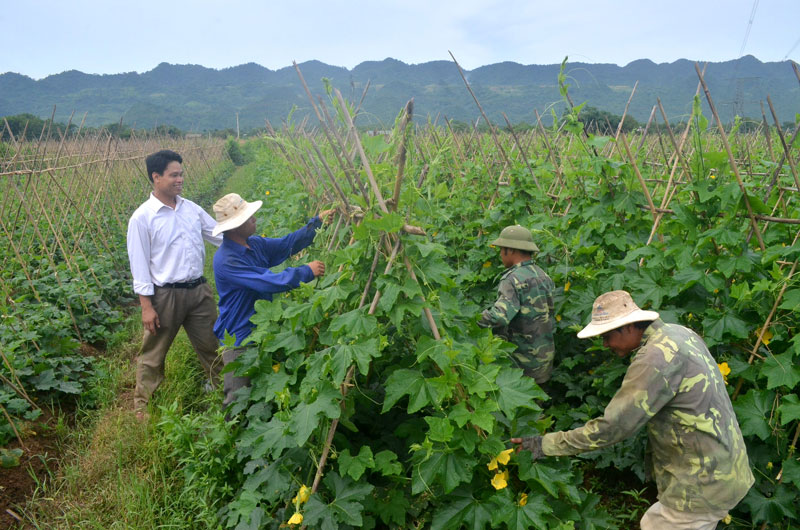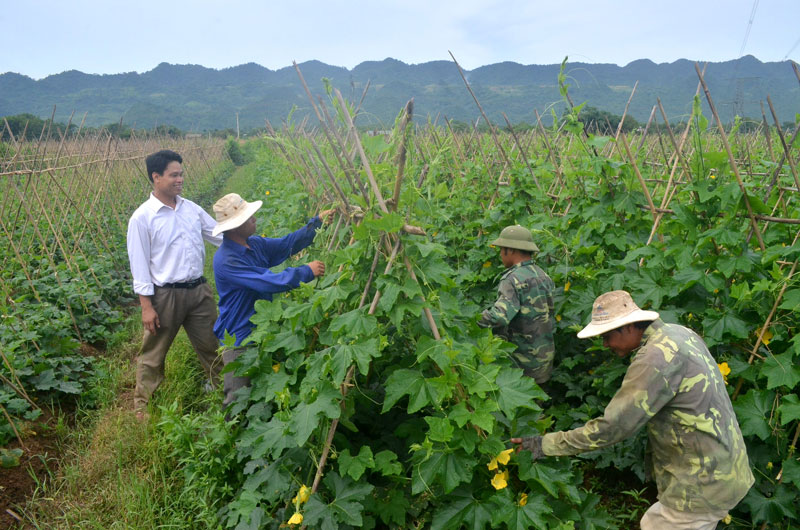
(HBO) – The northern province of Hoa Binh has taken firm steps in reforming its agricultural sector. Outstanding outcomes in the work included defining clear orientations and choosing suitable key plants and animals in service of making a breakthrough development of the sector in following years.

Photo: Locals in Nai village, Tan My commune, Lac Son
district successfully switch farming rice to water melons for higher
productivity.
The
agricultural sector has focused on applying measures to expand production of
products with higher productivity, and quality and value. The majority of
targets in agricultural restructuring have been completed.
Specifically,
the GRDP of the sector reached 4.37 percent in 2013 and 4.7 percent in 2016.
The productivity value of the sector reached 90.3 million VND per hectare in
2013 and 112 million VND per hectare in 2016. Value of each hectare of aquatic
farm hit 80.8 million VND in 2013 and 123 million VND in 2016. The ratio of locals
accessing clean water was 78 percent in 2013 and 88 percent in 2016.
At the
same time, many important policies for the sector have been designed in recent
years.
In
2014, the provincial Party Committee issued four resolutions, including those on
developing some major farm products, traditional trades, and trade villages,
increasing the breeding of fish in
Hoa
Binh
Lakein the 2014-2020 period, and supporting the sale of agricultural products.
The
provincial Party Committee also directed the realisation of measures to
implement the Party Central Committee’s resolution on agriculture, farmers and
rural areas.
In three
years from 2014-2016, the province raised awareness of local officials in
developing advantageous products of each region. Localities have selected
regions to develop their advantageous products, including the orange growing region
in Cao Phong, Lac Thuy and Kim Boi, the green-skin grapefruit growing area in
Tan Lac, the Dien grapefruit region in Yen Thuy, and Luong Son, an area growing
chayote vegetables in Tan Lac, Mau Chau, an area cultivating purple pepper in
Mai Chau, and an area planting organic vegetables in Luong Son.
The
regions showed outstanding economic efficiency, contributing to raising the
value of the cultivation sector. In
2014, the growth of cultivation was about 1.9 percent. The figure rose to 3.82
percent in 2016. The production value of the sector reached over 120 million VND
per hectare each year and even 500 million VND per hectare per year for citrus
fruits farms, and 250 million VND per hectare per year for vegetable farms.
This
is an important progress of the sector, showing steady steps forward of the
cultivation sector in the path of completing the set targets during the reform
process./.
Dao Village’s honey – a product certified with a 3-star OCOP (One Commune One Product) rating by Thong Nhat Agricultural Cooperative in Dao Village (Hoa Binh City) – is highly regarded by consumers for its quality, richness, and variety in packaging. The distinctively sweet taste of Dao Village’s honey leaves a lasting impression on anyone who has tried it.
In alignment with Project No. 07-DA/TU, issued by the Hoa Binh provincial Party Committee on November 1, 2021, Lac Thuy district has actively promoted investment and supported the sustainable development of its industrial and handicraft sectors during the 2021–2025 period. Alongside this, the district has remained committed to preserving and revitalising traditional craft villages.
Located in the northern part of Lac Thuy district, with a temperate climate and fertile soil, Phu Thanh commune has great potential and advantages in growing tea. The long-standing experience, combined with strict adherence to organic farming practices in the tea gardens, ensures that the dried tea products from Phu Thanh and Lac Thuy as a whole are sold out immediately upon production, providing a stable and prosperous life for the local people.
Amid efforts to streamline the administrative apparatus, Hoa Binh province has intensified measures to address challenges in land clearance, resettlement support, and infrastructure investment, aiming to speed up the progress of key projects.
Hoa Binh province has posted an unprecedented economic growth rate of 12.76% in the first quarter of 2025, marking its highest quarterly performance to date and positioning it as the second fastest-growing locality in the country, trailing only Bac Giang province.
Under current regulations, products in the One Commune – One Product (OCOP) programme that are rated three stars or higher must undergo re-evaluation every three months. However, in reality, some of these products fail to consistently meet the required standards, raising concerns about the sustainability of their OCOP certification. This underscores the urgent need for producers to enhance product quality and gradually develop their OCOP products into strong, marketable brands.



